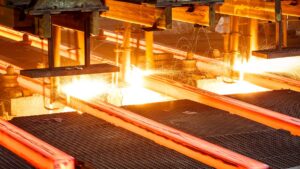Monsters of Rock: Why alumina supplies will struggle to meet demand from decarbonisation

Pic: Getty
- Alumina boss says medium term outlook for market for aluminium feedstock is very strong
- Decarbonisation and industrial growth will increase demand by 11Mt, 3.5 times planned new supply outside China
- BHP brings materials sector down as Deterra and Stanmore get bump from its quarterly review
Alumina Limited (ASX:AWC), the lucky ducks who own a non-operating 40% stake in the Alcoa World Alumina Chemicals business, is on a high right now with rising aluminium prices and supply disruptions putting a rocket up alumina demand.
The closure of Russian market leader Rusal’s Nikolaev refinery in Ukraine, sanctions on Australian experts to Russia, Covid issues, production curtailments and Chinese environmental measures have helped drive prices higher, Alumina CEO Mike Ferraro said.
“The alumina market price reached over $530 per tonne in March 2022 and averaged $498 per tonne for that month. The API currently sits at $371 per tonne, still well above the average price of $329 per tonne in 2021,” he said.
That has flowed through into $115.5m of distributions from AWAC to the ASX-listed Alumina in the March quarter taking its total for the year to $141.2m and more expected in May.
But while Ferraro noted a number of supply disruptions had caused price volatility over the past have years, the medium term outlook could support a supply-demand imbalance in the years ahead.
“The medium-term outlook for the alumina market is strong. Over the next five years, the expected and potential increase in primary aluminium production is 5.9 million tonnes per annum outside China due to industrial growth and a decarbonising world,” he said.
“This would require around 11 million tonnes per annum of extra alumina. Only 3 million tpa of additional alumina production is currently committed outside China in the next few years.”
China only exports at high prices, and it will take a long time to bring on new capacity outside the Middle Kingdom, according to Ferraro. This could lead to regional supply deficits.
“The global energy transition and growth in aluminium metal consumption driven by de-carbonisation are positive for the alumina industry,” he said.
“These fundamental positives for the medium term reinforce the
value of already established alumina assets which have long term energy, with ready access to bauxite, such as AWAC.”
Alumina (ASX:AWC) share price today:
BHP leads market lower
BHP’s (ASX:BHP) downgrades in nickel and copper and lower iron ore production saw the company lose 3.06% on the release of its quarterly operational review.
That led the market lower with losses across coal, iron ore and gold miners carrying the materials sector to a 1.6% fall.
Some of the strongest performances ironically came from companies who emerged as incidental winners of BHP’s quarterly.
Deterra Royalties (ASX:DRR), which counts its only real asset as a royalty over BHP’s Mining Area C, was up 1.46%.
BHP announced record quarterly production of 29.3Mt from MAC in the March quarter, where its new South Flank mine hit a 58Mtpa run rate and is ramping up to 80Mtpa over the next three years.
Stanmore Resources (ASX:SMR) was also up more than 5% after BHP confirmed it expects the US$1.2 billion sale of its 80% share in the BHP-Mitsui Coal business to the Indonesian backed miner to clear on May 3.
Monstars share price today:
Related Topics
UNLOCK INSIGHTS
Discover the untold stories of emerging ASX stocks.
Daily news and expert analysis, it's free to subscribe.
By proceeding, you confirm you understand that we handle personal information in accordance with our Privacy Policy.








